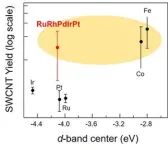(Press-News.org)
High entropy alloys (HEAs) have attracted significant attention in various fields due to their unique properties such as high strength and hardness, and high thermal and chemical stabilities. Unlike conventional alloys, which typically incorporate small quantities of one or two additional metals, HEAs constitute a solid solution of five or more metals in equal atomic ratio. This unique composition results in unique and complex surface structures that contain many different active sites suitable for catalytic reactions. As a result, in recent years, HEA nanoparticles (NPs) have been extensively studied for their catalytic potential.
However, despite their potential, HEA NPs have never been used as catalysts for growing single-walled carbon nanotubes (SWCNTs). SWCNTs, nanoscale tubes made up of carbon, exhibit remarkable properties such as exceptional strength and thermal and electrical conductivity, making them valuable in many fields like battery components and biosensors for biomedical and agricultural applications. Consequently, there is an urgent need for efficient synthesis methods for SWCNTs, necessitating the development of effective catalysts.
In a pioneering study, a team of researchers from Japan, led by Professor Takahiro Maruyama from the Department of Applied Chemistry at Meijo University, achieved for the first time, growth of SWCNTs using HEA NPs. “CNTs hold immense potential across numerous domains. If we can reduce their synthesis cost and achieve selective SWCNTs growth through catalyst improvements, it could pave the way for high-speed devices and various optical sensors, making our lives more comfortable,” says Prof. Maruyama, shedding light on the motivation behind their study. Their findings were made available online on March 06, 2024, and will publish in Volume 841 of the journal Chemical Physics Letters on April 16, 2024.
In previous studies, Prof. Maruyama’s team was successful in growing SWCNTs using single metals such as iridium, platinum, and rhodium as catalysts. Building upon their findings, in this study, they used HEA NPs comprised of five platinum group metals (5 PGM), including rhodium, rubidium, palladium, iridium, and platinum. Prof. Maruyama explains, “Considering that PGM HEA NPs often have higher activities than individual PGM catalysts, we theorized that HEA NPs composed of PGMs might act as highly active catalysts for growing SWCNTs.”
The team synthesized SWCNTs through the chemical vapour deposition (CVD) process, in which SWCNTs are grown by depositing layers of materials atom by atom on a solid surface in a vacuum. CVD was carried out using acetylene as the feedstock at 750 0C for 10 minutes with the 5 PGM HEA NPs as catalysts. This resulted in the growth of high-density SWNCTs with lengths longer than 1 micrometre. Additionally, Raman analysis showed that the SWNCTs had diameters in the range of 0.83–1.1 nanometres.
To compare the performance of the HEA NPs, they also synthesized SWNCTs using the individual metals as the catalysts, alongside iron and cobalt, the most commonly used catalysts for obtaining high-yield SWCNTs, in the same CVD process. Experiments revealed that the catalytic activity of HEA NPs was considerably higher than that of the individual PGM metals and was comparable to that of iron and cobalt. The team attributed this high activity to the unique surface structure of HEA NPs that provide various active sites for catalytic reaction owing to the diversity of their atomic structure.
“Our results show that 5 PGM HEA NPs are highly suitable for the growth of small-diameter SWNCTs, representing a completely new matchmaking between materials. Moreover, given the countless combinations possible for HEA composition, our study can pave the way for even superior catalysts,” remarks Prof. Takamura about the potential of their study.
Overall, this study demonstrates the effectiveness of HEA NPs as catalysts for the growth of high-quality SWCNTS, opening new avenues in carbon nanotube research.
END
INDIANAPOLIS – A large multi-state electronic health record-based study from the Centers for Disease Control and Prevention’s (CDC’s) VISION Network has found that COVID-19 vaccines are as effective for adults with anxiety or depression or mood disorders as for individuals without these common diagnoses. This is one of the first studies to evaluate COVID-19 mRNA vaccine effectiveness for those living with mental illness.
While vaccination provided similar protection regardless of psychiatric diagnosis (none, one or multiple ...
NEW YORK, NY (April 3, 2024) – Columbia University Vagelos College of Physicians and Surgeons (VP&S) will begin construction on New York City’s first all-electric university research building in May. The new biomedical research building in Washington Heights is designed by Kohn Pedersen Fox (KPF) and will house eight stories of laboratories and research facilities, collaboration corners, living walls, and community engagement spaces.
The new biomedical research building will become the center of Columbia’s efforts to gain new understanding of diseases and develop next-generation ...
2 April, 2024, Sydney; In a world first, a team of international scientists including three Australians, Al-Aabid Chowdhury and Professor Simon Ho from University of Sydney, and Dr Jacqueline Nguyen from Australian Museum and Flinders University, have determined the family tree of modern birds and pinpointed the timing of their evolution. Their findings have been published today in Nature.
The largest study ever undertaken of modern bird genomes, the scientists combined genomic data of more than 360 bird species with data from nearly 200 bird fossils to reconstruct the most well-supported Tree of ...
KEY TAKEAWAYS
Researchers from Mass General Brigham analyzed timing and location of gunshots in six of the most populated U.S. cities (Baltimore, Boston, Washington, D.C., New York, Philadelphia, and Portland, Ore.) from 2015-2021.
The team estimates that annually, approximately 12.5 million person-nights—the number of nights of gunshots multiplied by the number of people in earshot—are impacted by nighttime gunshots, and that those were more common in low-income areas in each city.
The noise of nighttime gunshots may have underrecognized and underappreciated effects on ...
Picture this disaster scenario in the making: At an industrial plant, a pipe cracks, spraying a cloud of tiny droplets into the air. Workers, however, are in luck. Within minutes, a laser-based device the size of a small suitcase spots the cloud and tells safety crews what’s in it so they know how to respond.
That’s the vision behind a new project from a team of engineers and chemists at the University of Colorado Boulder, California Institute of Technology, University of California Santa Barbara, and three companies. It’s ...
To better understand COVID-19’s spread during the pandemic, public health officials expanded wastewater surveillance. These efforts track SARS-CoV-2 levels and health risks among most people, but they miss people who live without shelter, a population particularly vulnerable to severe infection. To fill this information gap, researchers reporting in ACS’ Environmental Science & Technology Letters tested flood-control waterways near unsheltered encampments, finding similar transmission patterns as in the broader community and identifying previously unseen ...
As any surfer will tell you, waves pack a powerful punch. Now, we are one step closer to capturing the energy behind the ocean’s constant ebb and flow with an improved “blue energy” harvesting device. Researchers report in ACS Energy Letters that simply repositioning the electrode — from the center of a see-sawing liquid-filled tube to the end where the water crashes with the most force — dramatically increased the amount of wave energy that could be harvested.
The tube-shaped wave-energy harvesting device improved upon ...
Choosing paint for your home brings a lot of options: What kind of paint, what type of finish and what color? Water-based paints have emerged as “greener” and less smelly than solvent-based options. And they are often advertised as containing little-to-no volatile organic compounds (VOCs). But, according to research published in ACS’ Environmental Science & Technology Letters, some of these paints do contain compounds that are considered VOCs, along with other chemicals of emerging concern.
Paint consists of four ingredients: pigments, binders, additives ...
A fungus devastating frogs and toads on nearly every continent may have an Achilles heel. Scientists have discovered a virus that infects the fungus, and that could be engineered to save the amphibians.
The fungus, Batrachochytrium dendrobatidis or Bd, ravages the skin of frogs and toads, and eventually causes heart failure. To date it has contributed to the decline of over 500 amphibian species, and 90 possible extinctions including yellow-legged mountain frogs in the Sierras and the Panamanian golden frog.
A ...
When we communicate with other people face-to-face, we do so by maintaining a certain physical distance from each other. This space surrounding our body while interacting is called the interpersonal space (IPS), and maintaining adequate IPS is crucial for better communication.
Many studies have investigated the psychological and physiological changes that occur based on the presence of another person in the IPS during face-to-face interactions. These studies are based on the avoidance behaviour that we experience when a stranger invades our IPS, which manifests in the form of increased heart rate and discomfort. However, ...








